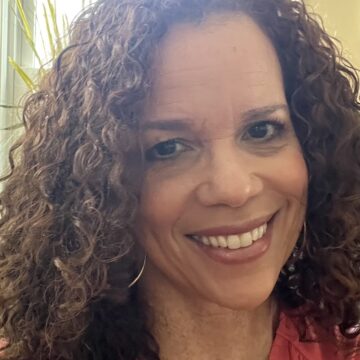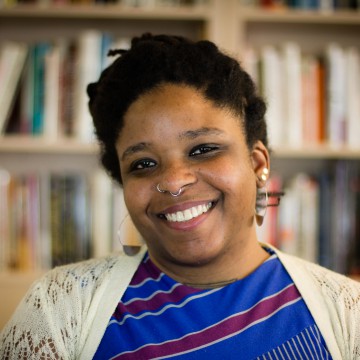Posted in Uncategorized
January 15, 2019
“We are the living conduit to all life. When we contemplate the vastness of the interwoven network that we are tied to, our individual threads of life seem far less fragile.”

Photo by Marie Voegtli, “network” shared under provisions of Creative Commons Attribution License 2.0.
Last week, we wrapped up the third annual Food Solutions New England Network Leadership Institute. For three years, we have been partnering with FSNE to cultivate and connect people in this region where IISC is based, who are committed to supporting the emergence of just, sustainable, collaboratively stewarded and self-determined food futures for all who live here. This network and leadership development initiative grew out of system mapping that FSNE undertook to identify four main areas of leverage to shift extractive, oppressive, oligarchic and life-depleting patterns of the dominant food system.
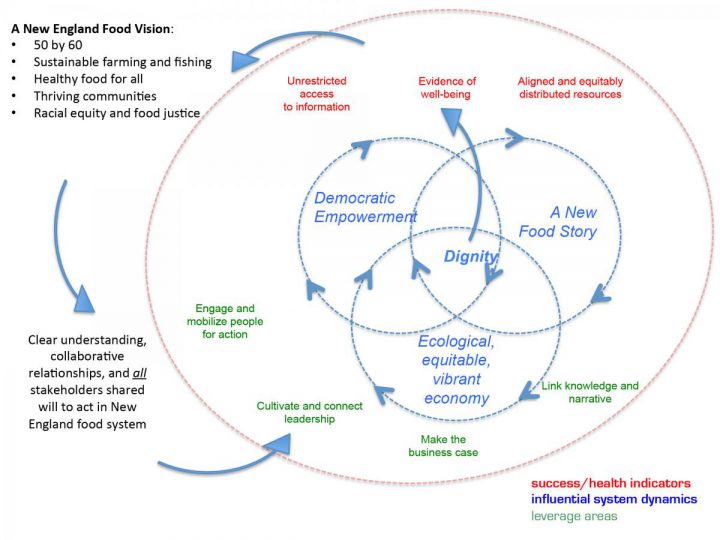
From the start, we and our partners at FSNE (including the backbone team at the University of New Hampshire Sustainability Institute, the FSNE Ambassadors, and members of the FSNE Process Team) knew that the main value of any kind of leadership development program would be in the people that came together and the relationships they built with one another. From there, we were interested in creating opportunities for those involved in the program to cultivate connections with other values-aligned change agents in the region. In addition, we looked at giving people an experience of different and diverse places in our region (rural, urban, coastal) and to see their work in a regional context. Lastly, we wanted to offer an opportunity for participants to hone their skills as collaborative/network leaders and equity champions.
Here is our working and ever-evolving definition of network leadership:
Network leadership operates from the understanding that connection and flow is fundamental to life and liveliness and that the nature and pattern of connection in a system underlie its state of health (including justice, shared prosperity and resilience). Network leadership strives to understand, shift and strengthen connectivity; facilitate alignment and resource flows; and create conditions for coordinated and emergent action in the direction of greater health and belonging at different systemic levels.
Read More
October 10, 2018
The board and staff of Interaction Institute recently gathered to learn from others working to bring about racial equity and to talk about how we build a board structure that supports or propels our work in new ways. To start the day, we did an icebreaker I called, “Reclaim for Liberation.”
A colleague planted this seed. What are the qualities or traits we once had that have been taken from us—by family dynamics or trauma, by histories of oppression, or as we have become adults and try to live in the dominant culture? And which of these do we actually want back?
Sometimes, as we are reaching for liberation, we find ourselves fighting against what exists. What we need more of is the vision of what we are heading toward. And sometimes, we imagine that we need completely new tools and skills and ways of being to get to our vision. What if we actually know (or used to know) most of what we need for transformation?
Growing up in this culture and transforming ourselves to fit, particularly as women and/or people of color and/or queer people, we shed things that are not only elemental to us but deeply important for our ability to move forward. Much of this is related to how white supremacy impacts our ways of being and asks most of us to be much smaller than nature would have us be.
When we did the exercise below, people told each other short stories of what they wanted to reclaim for the journey. The words that came up included play, song, dance, carefree, silly, laughter. And then the members of each small group used their bodies to create a sculpture embodying the words and feelings of their group.
It would have been even more effective if we then had kept those ways of being fully present throughout the day, particularly when more challenging conversations emerged. I would like now for us to practice bringing those skills into difficult conversations and see if they help us to speak and solve together.
Try this meditation and share what you see in the group. Do more possibilities or new pathways forward emerge as a result?
Reclaim for Liberation
Allow 20-30 minutes, ideally.
Let people know that in this work for liberation we sometimes feel that we don’t have all we need for change. And perhaps some of what we need we have lost on the way or was taken from us. We are going to spend time individually and as a group reclaiming some of the lost qualities that can be important to us now.
1. Start with a guided meditation (5-6 minutes to set up and lead people in and out)
- Ask people to take up space in the room; to spread out; can stand or sit
- Get planted—feeling souls of feet on ground, butt on chair if seated; close eyes or soft gaze
- 10 deep breaths
- Feel your body planted—feel the souls of your feet touching the ground, feel your hands resting on your legs or by your side
- Roll each shoulder back—breath into your full breadth, feel connected to those around you
- Hear the sounds of the room
- Breathe to elongate—feel the roots shooting down from feet, up from the crown of the head reaching toward the sky—feel your full length and integrity
- Ask people to travel back in years; begin to imagine a place you felt joy or lightness, a sense of freedom
- What sounds do you hear?
- What are you seeing around you?
- Are there any smells?
- Look around
- Are you inside or outside?
- Is this a place you recognize or a specific setting that is important to your childhood?
- Are there people around you or are you alone?
- Play in this space, enjoy the feelings.
- Is there a piece of yourself that is present that you may have left behind? Is there a feeling or essence of that self that you want to bring forward and reclaim? Is there something (playful, clear, relaxed) that may be useful for your liberation today?
- Draw people back to the room – come back into your body, hear the sounds around you, become more conscious of your breathing again, take time to come back into the room, and – when you’re ready – open your eyes.
2. In Trios (8-10 minutes) [decide in advance if there are any instructions needed about how to form trios—such as with people you don’t know or with whom you work less frequently]
- Each person gets a minute to share the quality that you want to bring forward. Ask yourself: What did I see in my younger self that might serve me in my liberation work today? Share a picture, words or a posture.
- Each group decides on a way to share back with the full group—encourage a physical sculpture or representation that captures everyone’s words or the quality of what was shared
3. Share back with group—up to 1 minute per group.
4. Ask people to call out some of the other words or feelings they want to carry into the day. You may want to capture some on a chart so you have a visual for your time together.
5. Decide as a group how you will keep pulling in these useful ways of being. This can be particularly useful if you have decisions to make or tensions to address. Ask people to consider an embodiment of their word or quality before engaging in such a conversation.
September 12, 2018

Image from Sharon Mollerus, shared under provisions of Creative Commons Attribution License 2.0.
As I’ve worked with a variety of social change networks to launch or transition from one stage to another, I’ve been guided by the following formula:
Form follows function follows focus
My experience is that many groups and initiatives can get very concerned about structure – How will we make decisions? Who will be members? What is expected of them? What do they get in return? These are important questions, and they deserve a fair amount of time tending to them. What can bog many groups down at this stage, however, is that they have not sufficiently sorted out the functions of the network, how it creates value, if you will, which has important implications for form. And if the group is not clear on its focus (purpose, animating goal, mission), this can be that much more perplexing.
So I’m spending more and more time with networks sorting out their core “jobs,” with a few additional guiding mantras, including:
Do what you do best and connect to the rest.
The value proposition of change networks in my mind is that they add value to a broader landscape of activity, not that they come in and try to take over. Even if this is not the intent, groups can spend little time figuring out what already exists “out there,” what efforts are underway, what other collective efforts are operating. This lack of awareness risks creating unnecessary and unhelpful duplication and competition. Read More
July 16, 2018
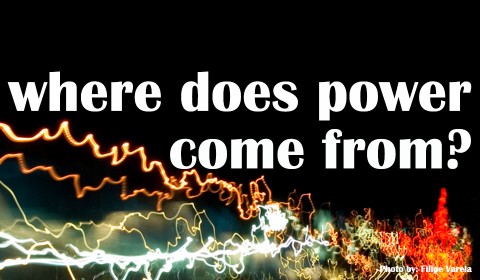
This is a repost of a third in a series of posts on power, facilitation and collaborative process that former IISC Senior Associate Linda Guinee wrote back in 2010. Last week we reposted Linda’s piece “What is Power Anyway?,” which followed a new post by a few of us on power and meetings. Enjoy!
More about power and group processes. There have been a mountain of books written about the “bases of power” and the “types of power”. I’ve done some work to try to boil it down – and find thinking about this very useful in moving forward the conversation about how to address power issues in group processes.
In the 1950s, French and Raven put out a proposal about five “bases” of power, which others added to. Bases of power are what gives a person or group power. French and Raven came up with these five:
- Reward Power – power that comes from the ability to reward the other party for complying
- Coercive Power – power that comes from the ability to punish the other party if they do not comply
- Legitimate or Normative Power – power that comes from accepted group, community or societal norms or values which are generally viewed as “legitimate”
- Referent Power – power that comes from being identified with a person or group (for example, so and so gains power by being friends with X or being a member of Y group)
- Expert Power – power that comes from the perception that the person or group has knowledge
Morton Deutsch later added a sixth:
- Ecological Power – power that comes from being able to control one’s social or physical environmental in such a way that the modified environment induces a desired behavior or prevents an undesired behavior.
Read More
April 19, 2018
IISC is pleased to offer the following three opportunities.
- Senior Associate
- People Operations Coordinator
- Training Coordinator
This search is being led by Imagine Consulting, a talent and recruitment firm specializing in supporting nonprofit organizations in securing an equitable and antiracist future for our world. Interested candidates should click here to apply. If you have questions or need support completing the application, please reach out to our team at careers@imagineimpactllc.com.
IISC’s Values
Our values are as important as the skills you will provide to our organization. These values guide IISC in our work internally and externally:
- We believe that social change is possible when three key elements are attended to: shared power and equity, network building, and love as a force for social change
- We believe that transformative leadership is the kind of leadership we need in the 21st century
- We believe in people’s right to be involved in the decisions that affect them so that they have influence over the quality of their lives
- We believe in the dignity of all human beings and in taking care of our planet so that we can all live healthy lives and our communities can thrive
Senior Associate
The Senior Associate works with organizations, networks, government agencies and communities to produce and deliver services that are committed to transformational, long-term change for racial equity. The Senior Associate also contributes to our evolving methodology and strategy, committed to peer learning, and contributes to IISC’s staff goals as we strengthen our equitable workplace. We currently have two openings for this role, with one of the positions will be focused on training and developing new curriculum and innovations.
Learn more and apply by 4/17.
People Operations Coordinator
Position Summary:
The People Operations Coordinator is responsible for overseeing the administrative tasks related to the HR, benefits, and operations functions of an organization. The position serves as a project manager for hiring coordination and preparation, manages the onboarding and offboarding processes, maintains employee records, tracks employee training, and ensures compliance with legal and regulatory agencies. The ideal candidate will be motivated by supporting staff of a mission-driven organization in advancing racial equity and social justice, while maintaining internal processes that align with the organization’s values and culture.
Learn more and apply by 4/7.
Training Coordinator
Position Summary:
The Training Coordinator is responsible for providing logistical support for public offerings and training sessions, ensuring successful, high-quality experiences for clients, staff, and participants. Their duties include assisting before and during sessions, answering questions, managing registration through an event ticketing system, and organizing data for reporting. They should be confident in providing support for both online training sessions using Zoom features as well as in-person public workshops. The ideal candidate is a well-rounded individual who can coordinate with all stakeholders to handle the finer details of training experiences, ensuring the successful completion of workshops for all involved.
Learn more and apply by 4/7.
IISC is an Equal Opportunity Employer.
January 31, 2018

Power. Networks. Love. These three aspects of the IISC’s Collaborative Change Lens were not the official theme of the Victory Institute’s 2017 International Lesbian, Gay, Bisexual, Transgender, and Queer (LGBTQ) Leaders Conference, but they were woven throughout everything that happened there.
The Victory Institute works to get LGBTQ people into elected and appointed office. Their annual conference brings together elected officials, leaders, and advocates for three-days. The content of the conference focuses on skill-building, information sharing, and formal and informal networking.
The first gathering of this group took place in 1984 with about a dozen people. Attendee John Heilman, city council member of West Hollywood, described the gathering as “more like a support group” than a conference. It has now grown to a convergence of over 500 attendees from all over the world.
Power
The reclaiming of power is central to the mission of the Victory Institute: “LGBTQ Victory Institute works to increase the number of LGBTQ people in public office and to provide programming, service and other support to help ensure their success.”
Why do we need more LGBTQ people in public office? With characteristic wit and bluntness, former U.S. Representative Barney Frank, the first person in Congress to come out voluntarily, said, “If you are not at the table, you are likely on the menu.”
The data tells the story this way: there is a direct correlation between the number of LGBTQs in elected office and the inclusion and equality of a jurisdiction’s policies.
Networks
In traditional ways, conferences tend to have a strengthening effect on networks. At plenaries and breakouts, attendees of the Victory conference had opportunities to connect around shared interests and maybe even to flirt a little. But the conference used the opportunity of the traditional schmoozing times to amplify traditionally marginalized voices. There was a “Leading in Color” reception which lifted up people of color, an International reception, and a Women Out to Win reception. The Institute also strengthened their pipeline for young leaders with the Victory Congressional Internship Meet & Greet.
Love
The feeling of love was palpable throughout the conference. Because of the bullying and harassment we’ve experienced, no one knows better than the LGBTQ community how much humans need to be celebrated and cheered. Whenever someone announced they were running for elected office, the audience burst into applause.
The spirit of love and humility was also present in a frequently repeated quote from Danika Roehm, the transgender metalhead stepmom, elected as the first openly transgender person to the Virginia Assembly – the first to serve in any state legislature actually. Roem won against Robert Marshall, the sponsor of a bill to restrict public bathroom use by transgender people, who referred to himself as Virginia’s “chief homophobe.” After the election, when asked if she had anything to say about Marshall, Roem said, “I don’t attack my constituents. Delegate Marshall is my constituent now.”
Pretty lucky constituent.
December 11, 2017
“We must make just and liberated futures irresistible.”
Toni Cade Bambara (via Adrienne Maree Brown)
At IISC, we are asking ourselves what we are trying to accomplish by helping the ecosystem of organizations, networks, and leaders pursue racial equity. Are we clear what we are fighting for? I believe we need to imagine what a society without oppression would look like in order to be able to explore this question. If oppression were a thing of the past, what would the world be like? If white supremacy and the drive to dominate didn’t ravage our cultures and minds, what would be available to us?
At IISC, we talk about the “Fourth Box,” the box that remains after we have eliminated inequities and achieved human liberation. I believe equity will exist when enough people and structures in societies have successfully dismantled the tools and ideology of oppression. But what is the liberation that follows after the breakdown of oppression? The word “liberation” can get a funny reaction in some quarters because it sounds like a 1970’s throwback civil rights expression, but it’s a deeply important concept.
What if liberation is the personal and transformational freedom that comes when our society is no longer rigged for the few – those who share similar characteristics or benefit from systems to concentrate their power?
What if liberation instead created a society that is centered on the notion that all human beings naturally belong in this universe? A society in which people live with autonomy, resources, creativity, inspiration, love, and human connectivity that makes life joyful, meaningful, and in alignment?
If we were to be fully liberated, what would that look like? I believe we would simply have time for being human. We would naturally spend time with those around us, appreciating their gifts and uniqueness. We would create play, laughter, and art in the ways we did as children but with the knowledge and insights acquired from our adult experiences. We would bring to human beings around us the power of presence – the relaxed unrehearsed connectivity that brings forth love and harmonious existence with all things living. We would build a fortified earth that yields food, sun, beach, ocean, sky, moon, mountains, lakes, clouds, and a vibrant and healthy climate to all.
We will soon be spending time at IISC examining our racial justice approach and methodology. It is my hope that we will start from the premise of the world without oppression and then think about how we can best help our clients and networks discover what that looks like, feels like, tastes like, and sounds like. Let’s suspend time and give people the opportunity to imagine themselves free from oppression and the tools they were taught to dominate others so they can live into practices that transform our world.
What would it look like to design racial equity interventions by helping people envision the end of oppression?
November 20, 2017
“We know that there is no help for us but from one another, that no hand will save us if we do not reach out our hand.”
– URSULA K. Le GUIN

Image by Stephen Bowler, shared under provisions of Creative Commons Attribution license 2.0.
A note on the quotes below (and the Le Guin quote above): I am grateful for the beautiful piece by Evan Bissel, “Frames for Life, Liberation and Belonging,” which appears in the Othering and Belonging Journal. This piece lifts up some central elements of an emerging and humanizing narrative for our times, with focus on themes such as transition, liberation, belonging, commons, interconnection, abundance, sacred, curiosity, play, and place. I strongly encourage readers to check it out, to sit with the piece and let it soak in, and to share it.
This post follows the thread of a conversation that has been evolving across events I have been involved with the past few months, and a bigger and broader conversation that is clearly informing it. This is certainly not a new conversation, but there seems to be a renewed or perhaps more public vigor to it, at least in multi-racial and multi-generational social change groups and initiatives with which I have been involved.
It has cropped up in a network leadership program where a discussion about the difference between working for equity and working for justice pointed in the direction of the need to pursue liberation, and not simply inclusion and accommodation in fundamentally harmful systems. Read More
October 12, 2017
A secret I don’t share with many people is that I have trouble reading books. When I went to law school, they made us read so many dense pages of legal reasoning I lost my love of story – until I discovered the podcast. In the comfortable confines of my car I stand witness to stories of personal accomplishment, quirks in our daily lives, and social commentary about our world. The other day one really caught my attention.
It was about Toys R Us, the biggest toy store in America. I love toys and I thought everyone else did, too. So I was surprised to learn that Toys R Us had filed for bankruptcy. Turns out, Toys R Us had invested in bricks and mortar without seriously expanding into the internet sales market. And at the same time, they kept those physical spaces disorganized, stale, and predictable. Amazon swooped in and sold toys at a record pace.
A toy and business analyst said if Toys R Us could have jumped in early and creatively into internet sales they would have avoided their decline. And if they had made their stores places of experience, fun, mystery, and discovery, they could have saved their business that way. He believed they should have created large and open areas where kids could ride around on bikes and play with other toys. He thought another miss was not thinking about how to combine physical toys with technological interactions.
As I was driving on the highway heading into traffic, I started thinking about lessons IISC or our network of clients and partners could learn from this story. Are we missing opportunities for integrating our knowledge and expertise with web-based learning and social media? Are we creating experiences in physical rooms and meetings that kick leaders and participants out of the norm and into experiences of fun, exploration, and surprise? Are we combining online and in-person strategies to more effectively and creatively share learning and ideas around collaboration, leadership, equity, and network building?
IISC is not a for-profit corporation like Toys R Us, and we have different values and approaches from them, but we can benefit from understanding that the way we do our work now and how we do our work may not be the standard for the decades to come.
IISC has started piloting some unique approaches in our workshops, in our consulting work, and through our experimentation with public engagement that use web-based learning, social media memes, and narrative. We are cooking up ways to fashion our training and consulting expertise in modular and less expensive ways so we can share it more broadly. I think that’s an early sign of us growing and stretching. We are pushing ourselves to domore experimenting and I know it’s going to help us stay relevant and live into the power of the future.
What experiments might you try out that will help you live into your future? What’s the risk of not doing so? Supporting leaders, organizations, systems, and networks to engage in social change is never out of date, but the way we as consultants and leaders approach that work might be. We may know at a gut level that something new and different is called for, but are we leaning into what’s necessary to make the leap?

Check out how Toys R Us plans to turn around: https://www.reuters.com/article/us-toysr-us-bankruptcy-brandon/toys-r-us-ceo-sees-future-with-smaller-shops-idUSKCN1BV2Y7
August 1, 2017
Stevie Johnston from our Belfast, Northern Ireland office reflects on learning from delivering a Training for Trainers in North Carolina.
When we’re teaching Facilitative Leadership for Social Change (FL4SC), we stress that the workshop is made up of leadership practices and – like all things in life (playing the guitar, dancing, listening), if we practice we get better at what we do. The more we use our leadership skills the better leader we become. This fits with our belief that leaders are made not born. Indeed, Malcolm Gladwell in his book ‘Outliers,’ disavows the idea of innate talent and focuses instead on the “10,000-Hour Rule.” His theory is that to achieve world-class expertise in any skill is, to a large extent, a matter of practising for approximately 10,000 hours.
Recently, I had the privilege of working with the leadership development team in the Charlotte Mecklenburg Schools in North Carolina, supporting them to become trainers of IISC’s Facilitative Leadership for Social Change workshop. During the workshop, each of the participants got the opportunity to deliver two of the core training elements. For highly skilled educational leaders such as these, developing and delivering a leadership training piece held no real anxiety. And yet, each of the trainers identified that the delivery of their second training piece was significantly better than their first. As Nicole said, “I was much more relaxed when it came to delivering my next piece. When you have the first delivery behind you, you have much more confidence in how to use the charts whilst keeping the connection with the participants. It means you can concentrate on the materials and the essence of what you are trying to communicate.” When we discussed this as a group, it was clear that performance anxiety can get to us all and that both practice and positive coaching have a real impact on our future performance.
Whilst we may not all reach the giddy heights of being world class, we are presented daily with opportunities to practice facilitative leadership. For example, organising an outing with friends requires collaborative planning and is a great opportunity to think about the actual mental processes we employ when we go about doing something like this. We have to get clear on the types and order of conversations we need to have such as these questions. “Are we looking for the perfect trip out?” “Do we need to think about people’s work schedules first?” “Could we not just grab our gear and hit the road?” We also need to get clear on who is going to make the decision if we can’t arrive at something on which we all agree. This “pathways thinking” about the nature of the conversations we need to have, in what order and how are we going to make the final choice, tends to stop groups from going round in circles and helps them arrive at a decision more readily and with less aggravation.
Similarly, we can employ process thinking when helping a colleague make an important personal decision. Often, we want to rush to tell them what we think they should do: “If I were you, I’d definitely do this.” Or else we will latch on to the first idea they have: “Yes, that seems like a really good idea; I’d go with that one.” In reality, decisions are best made when we generate lots of ideas and talk them through and evaluate the merits of each before choosing the best solution. Sound obvious? It is, and yet often we are not consciously aware of the processes which good decisions entail. So, the next time you’re having coffee with a friend to discuss a decision they have to make, think about how you are going to generate options (open the conversation), evaluate the options (narrow), and choose the best option (close).
Let’s keep on looking for those opportunities to practice and to get feedback and support as we do so. I may not reach the 10,000 hours, but over the course of a lifetime I plan to come close.
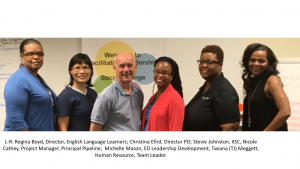
November 3, 2016
After four years of leadership, Ceasar McDowell has stepped down from his position as President of Interaction Institute for Social Change (IISC).
“I am thankful for the opportunity to have served as the IISC President for the last four years. I have the utmost respect for the IISC mission and staff, and am fully committed to helping IISC through this organizational transition,” Ceasar said. “The world needs the skill, talents, and knowledge of the Interaction Institute for Social Change.”
Under Ceasar’s leadership, IISC deepened its core competence: applying a collaborative approach to social change, infusing the value of racial equity into all community-based engagements, advancing the practice of network leadership, and harnessing love as the driving force for sustainable change. This work will continue under the leadership of Kelly Bates, who will serve as the interim Executive Director.
“It is an honor to serve IISC in this moment of change,” said Bates. “IISC will continue to offer and expand its portfolio of high-impact services to organizations, communities, and networks to build their capacity for more effective, equitable, and inclusive social change.”
Ceasar will continue his work at MIT in the Department of Urban Studies and Planning and we look forward to our ongoing collaboration.
August 1, 2016
Watching intermittent coverage of the Democratic National Convention my heart softened when I heard New Jersey Senator Corey Booker remind those listening that “Patriotism is the love of country, but you can’t love your country if you don’t love your countrymen.” He went on to define love as ‘being there for each other…empowering each other…finding common ground…and building bridges across differences…’ in pursuit of a common goal. He articulated a beautiful and hopeful vision of a nation of love as a free people, living interdependently. Later on during the convention, Broadway stars gathered on stage to sing the American classic, “What the World Needs Now is Love.”
It gave me a feeling of hope, not necessarily in the Party per se, but in the power of love to captivate the collective imaginations of millions of people who believe that another world is possible, and we can make it a better one for all of us.
Read More






